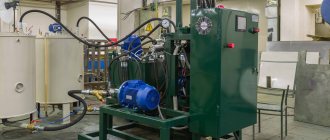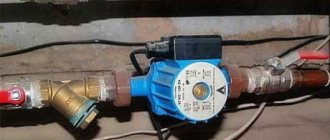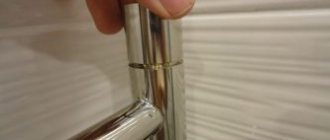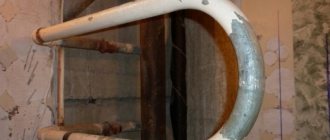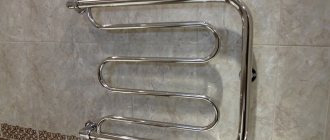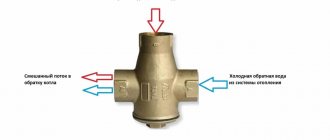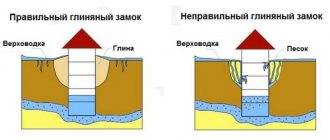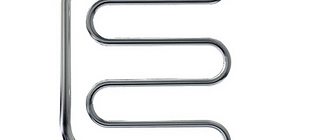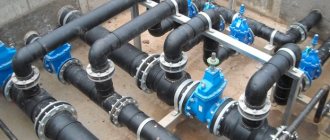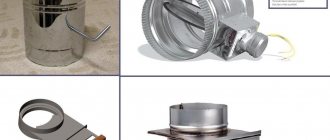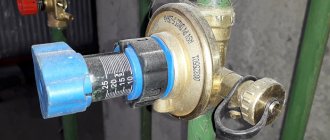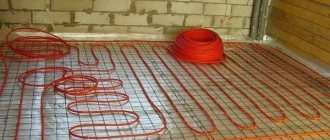Owners of heated towel rails from time to time face such a problem as leaking. Very often this problem occurs precisely at the junction points. If you notice that the joint is constantly wet and dripping, you definitely need to turn off the water! If your heated towel rail has a bypass installed, all you need to do is turn the tap handle. This needs to be done as soon as possible, since the pressure drop inside the pipes can further worsen the situation and the towel dryer may simply break. It is not always possible to immediately address the leak and eliminate it. Therefore, if you do not have time to carry out repairs, remove the dryer and put special plugs on the pipes.
Bathroom heated towel rail
Main causes of leakage
Such a nuisance as a leak can happen at any time. And not only with an old and long-used heated towel rail, but also with a new, recently installed one. The reasons for this can be very diverse:
- Heated towel rails that have been in use for a long time may be susceptible to corrosion. It should immediately be noted that not only the metal pipes themselves are subject to corrosion, but also the places where they are connected.
- Mechanical damage. In this case, a leakage problem may arise if the heated towel rail is accidentally damaged by some foreign object. Very often, mechanical damage occurs during renovations in the bathroom, as well as due to careless handling of the dryer.
- Wear of parts. This is the main problem. Due to the wear of rubber bands and gaskets, the dryer begins to leak precisely at the joints.
- Incorrect operating conditions. There are often cases when the characteristics of a heated towel rail completely do not coincide with the functioning of the system in the bathroom. For example, it can be noted that the coil may not be designed for pressure from the system at all.
- Poor quality installation. Negligence in the installation of plumbing products, as well as failure to follow simple rules during installation, can lead to a leak in the dryer.
- Defective equipment. Exceptions are quite rare, and mostly defective models very soon remind the owners of their shortcomings.
- Incorrectly routed pipes. During installation, the ends of the pipes may be brought out crookedly. In this case, you shouldn’t be surprised that after some time your heated towel rail starts to leak.
As you can see, there are a lot of reasons for this. Even an insufficiently tightened internal hexagon can cause you quite a lot of trouble, including leakage. That is why it is important to know not only the cause of the leak, but also a fairly good way to quickly stop this leak.
It is important to know what material your heated towel rail is made of
Repairing a leaking heated towel rail
There are only three reasons why the heated towel rail in the bathroom leaked:
- decreased tightness of the gasket or winding;
The threaded connection may drip due to a flattened gasket. defects in the ends of the mating parts of a threaded connection - a sharp edge cutting the gasket, jammed threads;
Defects in threads can cause leakage. electrochemical corrosion that corrodes the body of the heating device.
Electrochemical corrosion of heated towel rails.
To eliminate the cause of the leak, it is necessary to shut off the circulation in the heated towel rail, then drain the coolant from it.
The riser may be part of the heating system of an apartment building or belong to the hot water supply system.
Where to turn off the water
In Soviet times, heated towel rails were installed directly into the riser without a bypass or shut-off valves. This riser ran in the middle of the combined bathroom or bathtub, which significantly complicated the hidden wiring of this engineering system. Threaded coupling connection:
- the coupling is screwed onto a long fitting welded to the pipe;
- a linen or hemp winder is wound onto a short fitting welded to the heated towel rail;
- the ends of the fittings are aligned on one spatial axis, the coupling is screwed onto the short fitting;
- on the reverse side (long thread) the coupling is tightened with a lock nut.
Currently, developers place heated towel rail risers together with the rest of the hot water and hot water supply risers. Two lines are cut into them - supply, return, ball valves are mounted, and two water outlets are brought into the bathtub.
In all other cases, an intermediate option is used - a self-installed bypass - offset, thinned, open or hidden routing of pipes and shut-off valves.
Instead of steel pipes and risers, polypropylene pipes, American pipes or fittings with gaskets and union nuts are more often used.
Taps in the apartment
The easiest way is to shut off the circulation with taps specially installed for this purpose. In this case, the heated towel rail circuit must be cut into the riser in parallel so that circulation in the general house system is maintained.
Correct connection diagram for a substation with two taps.
However, the location of the leak may be in front of the shut-off valves or the heated towel rail is connected to a gap in the riser without a bypass. In this case, it is necessary to close the valves in the basement of an apartment building.
The main problems in this case:
- pressure remains in the system;
- the water from the riser will have to be drained completely or partially depending on the floor and supply pattern (bottom, top) on which the repair is being carried out.
Currently, the service of draining water from the riser is paid. In addition, the remaining residents connected to the same riser are deprived of hot water or heating during the repair.
Therefore, when the dryer starts to leak, you need to call the housing office or management company. However, the wait for emergency services may last indefinitely.
If water only drips from the connection, no further action may be required. For a strong fistula, you can apply a plumbing clamp yourself, as in the photo below.
How to fix a leak
There are more than one or two good ways that will help you once and for all, or at least for a long time, get rid of the leakage problem. So, first of all, it should be noted that the method of dealing with a leak depends on the cause of the leak. Therefore, if the heated towel rail is leaking due to corrosion damage, you need to turn off the water, remove the dryer and replace the equipment. Moreover, replacement must be made! Otherwise, increased pressure in the system and water hammer can lead not only to a leak, but also to a whole flood. In this case, it is very easy to avoid damage and leakage of the dryer. All you need to do is check the general condition of the device from time to time.
It is also recommended that after installing a new dryer, check the joints for moisture. If the heated towel rail is leaking, try to identify the problem as quickly as possible and completely eliminate it.
We remind you once again that the condition of the heated towel rail largely depends on the quality of the work performed. If you are doing the installation yourself, try to take this task as responsibly as possible.
Follow all instructions correctly, and if in doubt, seek help from specialists. So, if the ends of the pipes are brought out incorrectly (unevenly), you need to fix this. First you need to remove the dryer, then align the ends of the pipes. After this, you can reinstall the equipment, making sure to pay attention to sealing the joints. The weak point in the dryer is not only the gasket, but also the swivel assembly. In this case, installing new sealing materials will help you solve the problem. However, there are cases when it may be necessary to replace the entire rotary assembly.
Often, drips occur at threaded connections. In order to eliminate the leak in this case, you can use not tow, but a special gel sealant. After the gel is applied to the thread, it hardens quickly enough to turn into dense and durable plastic. Such a gel can not only protect you from leaks, but also save the thread from corrosion.
Corrosion is the main cause of heated towel rail failure.
How to bleed air from a heated towel rail.
Usually, before water is introduced into the hot water supply system, air accumulates in it. Accordingly, it ends up in the water supply systems of multi-storey buildings.
Air appears in the system as a result of centralized repairs of pipelines, replacement of valves, ruptures of house pipelines and other troubleshooting of the pipeline system.
Heated towel rails are usually connected to hot water supply. The reason for a cold towel when there is hot water in the taps is an air lock in the system or in the heated towel rail. To solve this problem you need to bleed the air from it.
To bleed air, a special device is installed on the heated towel rail - a Mayevsky tap. It has the form of a threaded nut, on which a rotating mechanism with a latch in the form of a square bolt with a slot for a straight screwdriver is screwed on top.
The turning mechanism is made of plastic. It has a hole that serves to direct the air flow. You need to bleed the air until water begins to flow steadily without air.
If after this the heated towel rail remains cold. Then you need to ask your neighbors on the upper floors to do the same steps at their place.
What can affect the leak?
It is very important to understand that the formation of a leak is affected not only by the material from which the heated towel rail is made, but also by the water in it. The quality of water currently used in all water supply systems leaves much to be desired. Only models made of stainless steel can resist its corrosive action and corrosion. However, when choosing a steel heated towel rail, you need to be extremely careful. Stainless steel models are quite popular nowadays and this leads to the fact that they are more often counterfeited than others. In order not to buy a fake or defective dryer, you must carefully inspect your future purchase and also ask for a quality certificate.
People who have country houses very often buy heated towel rails made of ferrous metals. Such products look quite beautiful. They will serve you faithfully for many years only if your bathroom has good ventilation and a well-equipped heating system. In an ordinary apartment in a multi-storey building, heated towel rails made of ferrous metal do not take root for long. They corrode and become clogged with small particles of sand, salt, as well as other micro-objects and impurities found in the coolant.
That is why it is very important to know what material your heated towel rail is made of and how long this material will be able to serve you under similar conditions and irritants.
The heated towel rail is leaking, what should I do?
You notice that your heated towel rail is leaking . Something needs to be done, as the women say.
Do I need to turn off the water?
Situation 1. It is definitely necessary if water flows out in significant volumes and there is a serious risk of flooding your bathroom, apartment and neighbors below. We are looking for a couple of containers and organizing duty to drain the water in a timely manner, while we ourselves run (call) to the housing office and insistently demand that the water be turned off. To be convincing, you can promise a lot - you don’t have to choose, repairing the neighbor’s apartment will be more expensive.
Which heated towel rail doesn't leak?
No matter how sad it may be, when a heated towel rail leaks, in some cases it needs to be completely replaced. Of course, replacing bathroom equipment requires money, and every time people buy a new dryer, they give their money in the hope that this one will definitely not leak. But the problem happens again. And then the question arises: “Is there a heated towel rail that doesn’t leak?” Of course there is!
Corrosion on the heated towel rail
A heated towel rail with no water will never leak. So, if you are tired of water appliances, you can easily replace the water heated towel rail with an electric one, and it will certainly never leak. Electric models have many advantages:
- The very first and most important of them is that an electric heated towel rail never leaks!
- It is also independent of system pressure and hot water supply.
- Installing and maintaining the electric model is quite simple.
- You can control the heating temperature of the dryer yourself.
- If you have nothing to dry, you simply turn off the heated towel rail and it does not consume electricity.
It’s safe to say that electric models will be able to replace water heated towel rails and will fit well into bathrooms. But electric models also have some disadvantages. The most significant of them is the use of electrical equipment in conditions of high humidity. What to do in this case? Is it really possible that the only dryer that doesn’t leak can’t be installed in the bathroom? Of course you can! But this must be done by a professional! Professionally performed work will allow you to avoid electric shock.
An electric heated towel rail will save you from headaches about leaks.
Water seeps through threads
When the water sockets are located in the wall, in the immediate vicinity of the place where the heated towel rail is installed, for example, a “ladder” with a bottom connection, it is convenient to use an assembly of metal threaded fittings, brass or stainless steel, for connection. A “nipple” is connected to the water socket; after it, if necessary, an extension cord, an angle with internal or external thread, then an American female and an adapter coupling can be installed.
It is quite possible that one of the elements of this connection leaked, was not tightened securely enough during installation, or there is not enough winding somewhere. As a result, the entire structure leaks. What to do in such a situation?
First of all, you need to carefully inspect all the connections from this assembly and make sure that it is flowing along the threads. The problem may be elsewhere: for example, the American one has a bad gasket and is leaking from under the union nut. Then try tightening the nut with a wrench first.
If upon inspection you are convinced that the leak is indeed in the threaded connection, unscrew the fittings and take flax and plumbing paste. Many people prefer to use Unipak paste; it is designed to work at temperatures up to 140°C and does not affect water quality. In addition, together with flax fibers, it provides good tightness and makes it possible to make adjustments when assembling the joint.
You can use other similar pastes and silicone sealant. Previously, they used drying oil and red lead, but after applying paint, it is almost impossible to disassemble such a compound. For winding it is better to use old reliable flax. Fum tape does not provide such quality; it is more suitable for conical connections.
Before winding flax, thoroughly clean the threads of dirt. Winding is carried out evenly along the entire length of the thread, in the direction of its pitch. An even layer of paste is applied on top. After a little while, you can assemble and stretch the fittings and reconnect the heated dryer.
conclusions
To avoid leaks, as well as frequent breakdowns of the heated towel rail, it is necessary to handle repair work responsibly. If you don’t know how to cope with a particular task, there is no need to improvise; it is better to invite a specialist who will tell you how to cope with this or that task. When a professional does the work, the risk of leakage is significantly reduced, and heated towel rails serve their owners for a very long time.
We wish you that your heated towel rails rarely fail, and that the breakdowns are completely insignificant.
